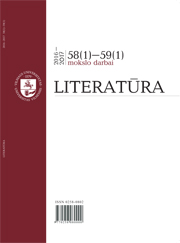Gendručio Morkūno kūryba vaikams ir jo „Grįžimo istorija“ literatūros teologijos požiūriu
Children’s works by Gendrutis Morkūnas and his Grįžimo istorija (Story of return) from the standpoint of the theology of literature
Author(s): Asta GustaitienėSubject(s): Christian Theology and Religion, Short Story, Lithuanian Literature, Philosophy of Religion, Hermeneutics
Published by: Vilniaus Universiteto Leidykla
Keywords: the best of children’s books; children's literature; Gendrutis Morkūnas; literary theology; Christian philosophy; religious and spiritual experience; wisdom; transpersonal identity;
Summary/Abstract: The aim of this article is to investigate children’s literature works by Gendrutis Morkūnas, focusing on the semantics of his problem prose piece Grįžimo istorija (Story of Return) written in 2007. Gendrutis Morkūnas wrote all his five books within a span of a few years at the beginning of the 21st century, and they are included in the list of the 500 best books for children by Lithuanian authors, while the author’s books Iš nuomiško gyvenimo (Bits from a Tenant’s Life), Blusyno pasakojimai (Stories from a Flea Place) and the aforementioned Grįžimo istorija (Story of Return) are among the first hundred entries of said list. What is the importance of the aspect of Catholic theology in Morkūnas’s works? To what extent does it help in revealing the subtlest meaning of his writings? When defining the theology of literature as a literary school of investigation, we mostly refer to the theoretical insights of art historian and religious philosopher Alejandro R. García-Rivera and his concept of the theology of art; the theoretical insights of psychologist Tobin Hart, literature scholars Sharon A. Stinger and Dalia Čiočytė and philosophers Luc Ferry and Arūnas Sverdiolas were also important in defining the problematic field of this article. The children’s literature works of Morkūnas are frugal in disclosing Christian motifs explicitly; however, the Christian underlayer is not to be ignored – the artistic reality of the works is interwoven with well-known biblical metaphors and images. A person’s name as a sign of one’s dignity gains its importance as an outstanding motif that unfolds very much like in John 10:3, the antinomy of the way and the path is recurrent in the works, together with the sometimes very persistent motif of knocking etc. These aspects, characteristic of Morkūnas’s works, manifest themselves in his book Grįžimo istorija (Story of Return). Here the author presents a story about a girl named Vilija – an original character to be memorized – who embodies a power characteristic of a small girl, which, as defined by Hart, brings the child close to experiencing God: she likes to observe, is wise and capable of wondering, prone to look for answers and able to guess what the adults are thinking, to recognize their most profound needs, and she is able see what is not to be seen, what had happened some time ago and what will always remain within linear time.
Journal: Literatūra
- Issue Year: 59/2017
- Issue No: 1
- Page Range: 68-86
- Page Count: 19
- Language: Lithuanian

